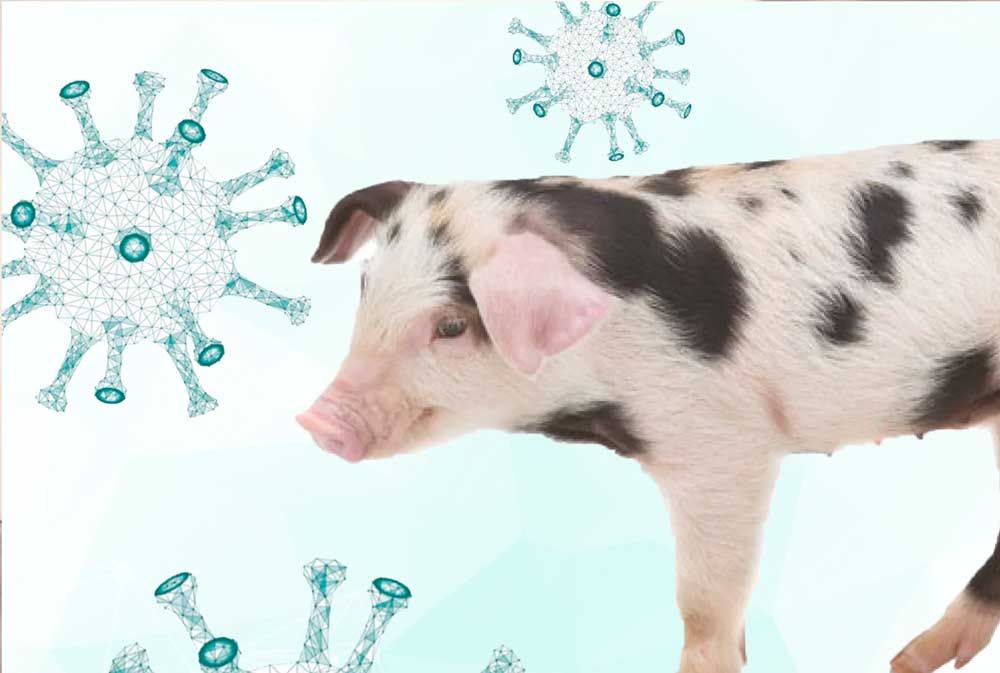Porcine Reproductive and Respiratory Syndrome (PRRS) is a viral disease that affects pigs and is distributed worldwide, causing heavy economic losses in the pig farming sector. This virus belongs to the order Nidovirales, family Arteriviridae, genus Porartevirus. The species PRRS1 and PRRS2, previously called European (EU) and American (NA) genotypes, respectively, have been described. The viral genome contains ten open reading frames (ORF).
Its marked genetic instability explains the variability of the PRRS virus and the diseases they cause. Two groups of strains are identified: those of the North American type and those of the European type. The main routes of entry of the virus to previously free pig populations are carrier pigs or semen; Prolonged viraemic periods and virus excretion in nasal and salivary secretions (up to 25 days) or semen (up to 90 days) contribute to its distribution. The virus survives for less than 24 hours in the environment in hot, dry conditions, but it can be transmitted short distances through the air, or longer distances through contaminated equipment, trucks, or insects. Survivals in the environment of up to 30 days have been described, at temperatures below 4 ºC.
Once on the farm, the virus can be transmitted from one pig to another via the placenta, by inhalation of the aerosol or by ingestion of contaminated material, although the main route of infection is parenteral inoculation through skin wounds, unsterilized needles , cutting teeth or tail, and biting insects. An important role in the infection cycle of a typical farm is played by the transfer of a small number of viremic piglets, born from viremic sows, from the breeding house to the weaning house, which will result in horizontal transmission to mates. group during the weaning and fattening phases. A herd may be infected with multiple PRRS virus strains in series or in parallel; immunity against each of them may or may not offer cross-protection, depending on their similarity.
The severity of clinical symptoms will depend on the virulence of the existing PRRS virus strain, the inherited susceptibility of pigs, previous immunity obtained against similar field or vaccine strains, and the presence of other endemic infections.
The reproductive picture usually appears at farrowing (after 100 days of gestation), in which litters appear with a mixture of apparently normal piglets, piglets with low viability and dead and/or mummified piglets. Sows infected at the beginning of gestation can abort and present irregular returns of heat, although most cases appear in the last third of gestation. At a later stage of the outbreak, mummified piglets are smaller, reflecting infection at an earlier stage. Sows may present agalactia, depression, fever, skin discoloration and a mortality of the order of 1-4%. Lethargy, depression and reduced libido may occur in boars during the acute phase. Sperm quality is reduced for a period of between 2 and 10 weeks after infection. In the post-weaning period, the main symptoms of PRRS infection are reduced weight gain, variable irregular growth with hairy or thin piglets, dyspnea, and a higher frequency of other endemic infectious diseases that were already present in the sow. such as salmonellosis, Haemophilus parasuis infection (Glässer’s disease), Streptococcus suis meningitis or arthritis, bacterial pneumonia, and porcine circovirus (PVC) infection. Often the postmortem image is distorted by the presence of other endemic diseases, but in a pure PRRS infection the lungs appear tan, are not collapsed, and have a rubbery texture. Histopathologic examination reveals interstitial pneumonia.
For a rapid detection of PRRSV, ID.vet presents us the tests ID Screen® PRRS Indirect, an Indirect ELISA test for the detection of antibodies directed against European and American PRRSV strains in serum and plasma, With high specificity and sensitivity, Efficiently detects European (EU-PRRSV, type 1) and American (US-PRRSV, type 2) strains and with results in only 75 minutes.
It also introduces us ID Gene™ PRRSV Triplex, Real-time RT-qPCR for the qualitative detection of two target sequences from EU and US genotypes of the Porcine Reproductive and Respiratory Syndrome Virus (PRRSV) genome in whole blood, serum, organ, tissue, bronchial swab, oropharyngeal fluids or cell culture supernatant.

